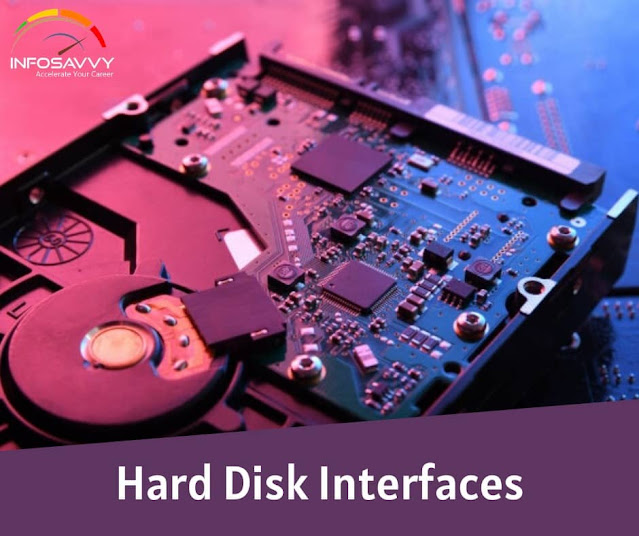Hard Disk InterfacesPosted by Infosavvy on May 31st, 2021 Hard Disk Interfaces in this the hard disk drive connects to the PC using an interface. There are various types of interfaces: IDE, SATA, Fiber Channel, SCSI, etc. 1. ATA DATA (IDE/EIDE)IDE (Integrated Drive Electronics) is a standard electronic interface used between a computer motherboard’s data paths or bus and the computer’s disk storage devices, such as hard drives and CD-ROM/DVD drives. The IBM PC Industry Standard Architecture (ISA) 16-bit bus standard is base for the IDE interface, which offers connectivity in computers that use other bus standards. ATA (Advanced Technology Attachment) is the official American National Standards Institute’s (ANSI) name of Integrated Drive Electronics (IDE). 2. Parallel ATA: PATA, based on parallel signaling technology, offers a controller on the disk drive itself and thereby eliminates the need for a separate adaptor card. Parallel ATA standards only allow cable lengths up to 46 centimeters (18 inches). Features of PATA:
Related Product : Computer Hacking Forensic Investigator | CHFI 3. Enhanced Integrated Drive Electronics (EIDE) Most computers sold today use an enhanced version of IDE called Enhanced Integrated Drive Electronics (EIDE). IDE drives connect with PCs, using an IDE host adapter card. The IDE controller in modern computers is a built-in feature on the motherboard itself. Enhanced IDE is an extension to the IDE interface that supports the ATA-2 and ATAPI standards. Two types of Enhanced IDE sockets are present on the motherboard. A socket connects two drives, namely, 80 wire cables for fast hard drives and a 40-pin ribbon cable for CD-ROMs/DVDRUMs. Enhanced or Expanded IDE is a standard electronic interface, connecting a computer’s motherboard to its storage drives. EIDE can address a hard disk bigger than 528 Mbytes and allows quick access to the hard drive as well as provides support for Direct Memory Access (DMA) and additional drives like tape devices, CD-ROM, etc. While updating the computer system with bigger hard drive, insert the EIDE controller in the system card slot. The EIDE can access drives larger than 528 Mbytes using a 28-bit Logical Block Address RBA) to indicate the actual head, sector, and cylinder locations of the disk data. The 28-bit Logical Block Address provides the information, which is enough to denote unique sectors for an 8.4 GB device. 4. Serial ATA Serial ATA (SATA) offers a point-to-point channel between the motherboard and drive. The cables in SATA are shorter in length as compared to PATA. It uses four-wire shielded cable that can be maximum one meter in length. SATA cables are more flexible, thinner, and less massive than the ribbon cables, required for conventional PATA hard drives. Features of SAM:
Drive and motherboard connectivity through a SATA point-to-point channel is based on serial signaling technology. This technology enables data transfer of about 1.5 Gbps in a half-duplex channel mode. Also Read : Logical & Physical Structure of a Hard Disk 5. SCSI SCSI is a set of ANSI standard electronic interfaces that allow personal computers to communicate with peripheral hardware such as disk drives, tape drives, CD-ROM drives, printers, and scanners. Developed by Apple Computer and still used in the Macintosh, the present sets of SCSls are parallel interfaces. SCSI ports continue to come as built-in feature in various personal computers today and gather supports from all major operating systems. In addition to faster data rates, SCSI is more flexible than earlier parallel data transfer interfaces. SCSI allows up to 7 or 15 devices (depending on the bus width) to be connected to a single SCSI port in daisy-chain fashion. This allows one circuit board or card to accommodate all the peripherals, rather than having a separate card for each device, making it an ideal interface for use with portable and notebook computers. A single host adapter, in the form of a PC card, can serve as a SCSI interface for a laptop, freeing up the parallel and serial ports for use with an external modem and printer while allowing usage of other devices in addition. Read More : https://info-savvy.com/hard-disk-interfaces/ ------------------------------------------------------------------------------------------------------------------------- This Blog Article is posted by Infosavvy, 2nd Floor, Sai Niketan, Chandavalkar Road Opp. Gora Gandhi Hotel, Above Jumbo King, beside Speakwell Institute, Borivali West, Mumbai, Maharashtra 400092 Contact us – www.info-savvy.com Like it? Share it!More by this author |



